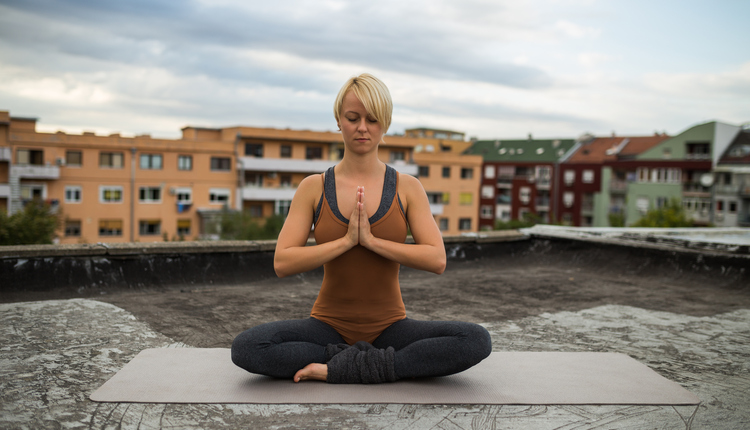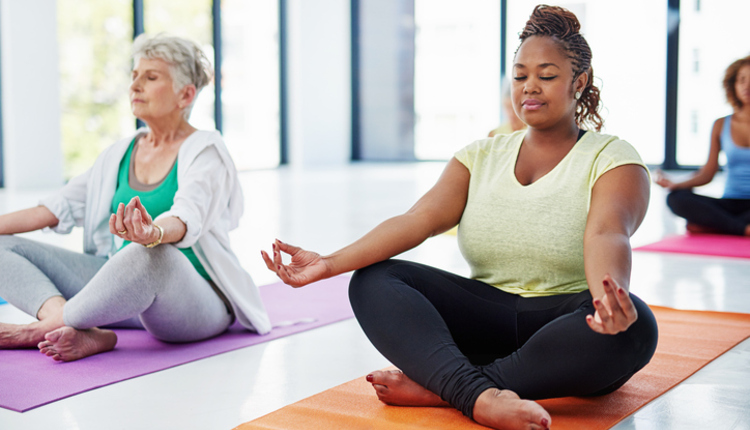
Yoga inherently acts as a powerful medicine for the mind. It teaches us how to engage the parasympathetic nervous system at will, helping regain emotional control over our bodies. This is why yoga is so good for treating Post-Traumatic Stress Disorder (PTSD). Yoga helps people learn the signals of when their bodies are moving into fight or flight mode, and can help them overcome the fallout of traumatic events.
Post-Traumatic Stress Disorder, which is the name given to the severe condition that develops after a person is exposed to one or more traumatic events, is affecting our soldiers both abroad and at home. A recent report from the Department of Veterans Affairs showed that since September 11th, nearly 30 percent of the Iraq and Afghanistan veterans - roughly 250,000 people - treated at hospitals and clinics have been diagnosed with PTSD. Multiple deployments have an immense impact on our troops, and are more than three times as likely to screen positive for PTSD or other emotional disorders. Also out of all of the Vietnam Veterans, many of which are just now seeking medical help, 30% have PTSD.
Symptoms common of PTSD are avoiding loved ones, recurring traumatic flashbacks, inconsistent memories of the traumatic event and unfathomable anxiety. It also causes night terrors and depression, manifesting itself in overeating, abuse of drugs and alcohol or withdrawal from society.
Luckily there has been more yoga-related research done in the last 5 years than ever before, and specialists are beginning to look at how yoga can treat those suffering from traumatic experiences. The Department of Defense funded a medical research project in 2008 to explore ways in which yoga can benefit those suffering from PTSD. The study hasn't been completed yet but results so far have shown that more than 50 percent of the participants saw a drop in PTSD symptoms after practicing yoga for an hour a day.
This deeper, more scientific understanding of exactly how yoga can help those suffering from PTSD as well as anyone with unresolved physical or emotional traumas, is playing a role in physicians warming-up to the idea of prescribing yoga practice to veterans and their families.
It has been shown that yoga, meditation and other somatic treatment modalities, helps those with PTSD and chronic stress much more than therapy. The yogic approach to healing helps release physical and neurologically-held tension in the body and teaches students how to tolerate sensations in their body. Additionally, yoga's body-focused approach increases mental self-awareness, self-regulation and self-efficacy which are necessary when healing the mind.
This advancement of understanding of what makes yoga efficacious includes: slower mindful movement to awaken the emotional or limbic center of the mind; ujayi breath focus to stimulate the vagus nerve; and a physical focus on psoas and grounding postures to help release the allostatic load of traumas stored in the body. This combination allows for organic healing through yoga therapy and provides a new path forward for those suffering from not only PTSD but mood disorders such as depression and anxiety.
We must also remember that those in the military aren't the only ones who are suffering from PTSD. About 60% of men and 50% of women experience at least one traumatic event in their lives. Men are more likely to experience physical assault, combat or to witness death or injury; and the families of military service members have a much higher chance of developing PTSD.
Even if you aren't suffering from trauma, mindful yoga practice leads to a healthy balanced body and mind. Yoga can help you decrease emotional reactivity as we learn to embrace life more fully. By practicing yoga, you can reframe situations so that you find more meaning even from difficulties and challenges. Essentially, yoga helps you reclaim that lost power, which is very important in healing trauma. Although we cannot control external events, we can use yoga to control our reaction.
Post-Traumatic Stress Disorder, which is the name given to the severe condition that develops after a person is exposed to one or more traumatic events, is affecting our soldiers both abroad and at home. A recent report from the Department of Veterans Affairs showed that since September 11th, nearly 30 percent of the Iraq and Afghanistan veterans - roughly 250,000 people - treated at hospitals and clinics have been diagnosed with PTSD. Multiple deployments have an immense impact on our troops, and are more than three times as likely to screen positive for PTSD or other emotional disorders. Also out of all of the Vietnam Veterans, many of which are just now seeking medical help, 30% have PTSD.
Symptoms common of PTSD are avoiding loved ones, recurring traumatic flashbacks, inconsistent memories of the traumatic event and unfathomable anxiety. It also causes night terrors and depression, manifesting itself in overeating, abuse of drugs and alcohol or withdrawal from society.
Luckily there has been more yoga-related research done in the last 5 years than ever before, and specialists are beginning to look at how yoga can treat those suffering from traumatic experiences. The Department of Defense funded a medical research project in 2008 to explore ways in which yoga can benefit those suffering from PTSD. The study hasn't been completed yet but results so far have shown that more than 50 percent of the participants saw a drop in PTSD symptoms after practicing yoga for an hour a day.
This deeper, more scientific understanding of exactly how yoga can help those suffering from PTSD as well as anyone with unresolved physical or emotional traumas, is playing a role in physicians warming-up to the idea of prescribing yoga practice to veterans and their families.
It has been shown that yoga, meditation and other somatic treatment modalities, helps those with PTSD and chronic stress much more than therapy. The yogic approach to healing helps release physical and neurologically-held tension in the body and teaches students how to tolerate sensations in their body. Additionally, yoga's body-focused approach increases mental self-awareness, self-regulation and self-efficacy which are necessary when healing the mind.
This advancement of understanding of what makes yoga efficacious includes: slower mindful movement to awaken the emotional or limbic center of the mind; ujayi breath focus to stimulate the vagus nerve; and a physical focus on psoas and grounding postures to help release the allostatic load of traumas stored in the body. This combination allows for organic healing through yoga therapy and provides a new path forward for those suffering from not only PTSD but mood disorders such as depression and anxiety.
We must also remember that those in the military aren't the only ones who are suffering from PTSD. About 60% of men and 50% of women experience at least one traumatic event in their lives. Men are more likely to experience physical assault, combat or to witness death or injury; and the families of military service members have a much higher chance of developing PTSD.
Even if you aren't suffering from trauma, mindful yoga practice leads to a healthy balanced body and mind. Yoga can help you decrease emotional reactivity as we learn to embrace life more fully. By practicing yoga, you can reframe situations so that you find more meaning even from difficulties and challenges. Essentially, yoga helps you reclaim that lost power, which is very important in healing trauma. Although we cannot control external events, we can use yoga to control our reaction.





